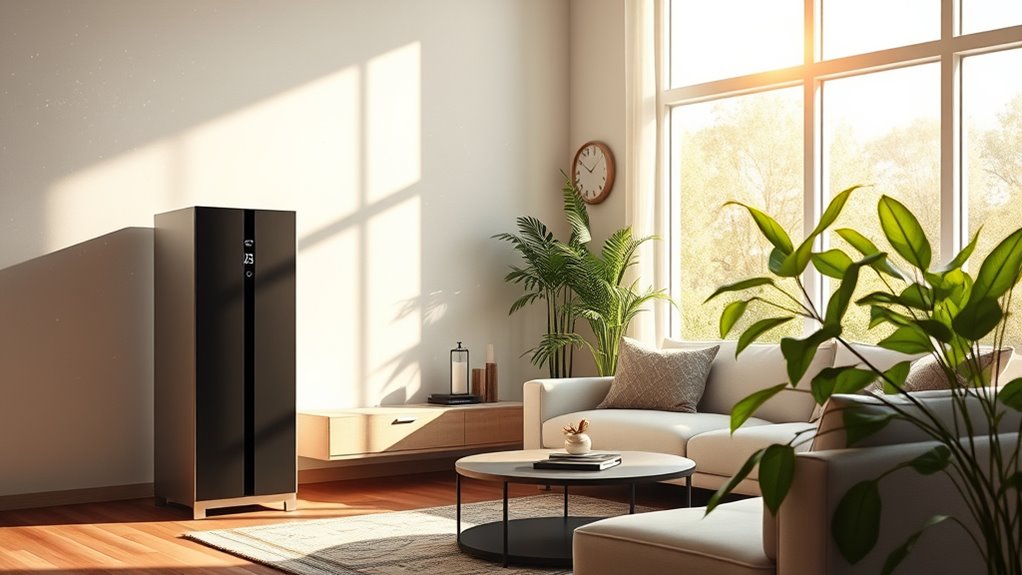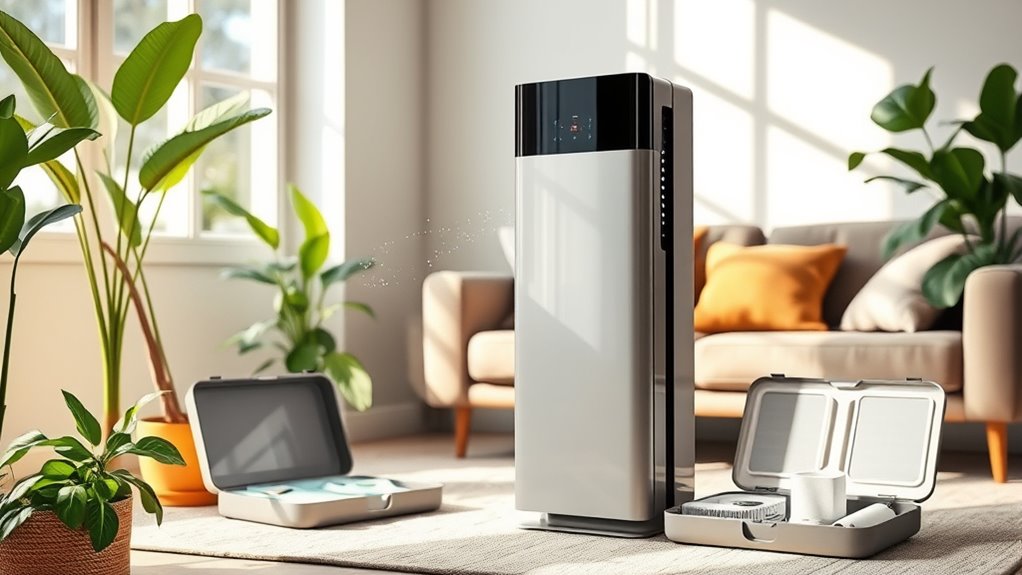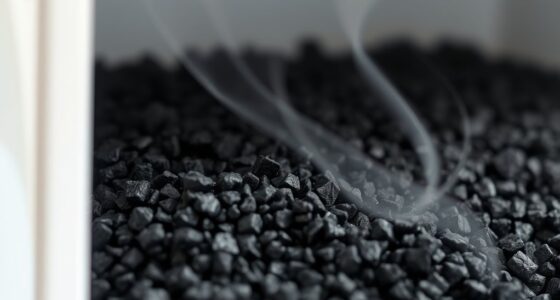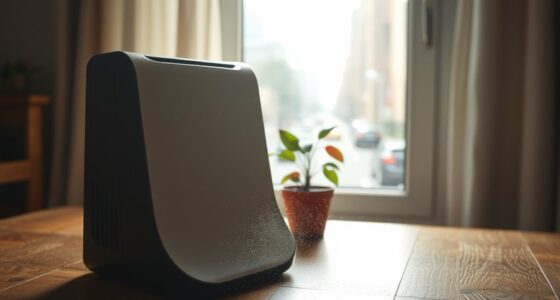In 2025, air purifiers are must-haves for your home due to rising air pollution and its health impacts. They improve indoor air quality by capturing allergens and irritants, which is essential for respiratory health and better sleep. With technologies like HEPA filters and activated carbon, these devices effectively tackle airborne pollutants. Plus, regular maintenance guarantees peak performance. Keep exploring why investing in an air purifier can transform your living environment for the better.
Key Takeaways
- Air purifiers are essential for combating the increasing air pollution levels and maintaining healthy indoor air quality amid rising health concerns.
- With indoor air pollution often 2 to 5 times worse than outdoor air, air purifiers are crucial for respiratory and overall health.
- HEPA filters in air purifiers capture 99.97% of airborne particles, making them vital for allergy sufferers and those with respiratory conditions.
- Regular maintenance of air purifiers ensures optimal performance, contributing to better sleep quality and reduced irritants in the home environment.
- As awareness of air quality grows, energy-efficient air purifiers are becoming necessary for sustainable living and reducing health risks in homes.
The Growing Need for Clean Air

As air pollution continues to pose a significant threat to global health, the need for clean indoor air has never been more pressing.
Studies show that indoor air can be 2 to 5 times more polluted than outdoor air, making air purifiers essential for maintaining good indoor air quality. Household air pollution from airborne particles and volatile organic compounds (VOCs) can severely impact your respiratory health, triggering asthma and allergies in millions. By using air purifiers equipped with activated carbon filters, you can effectively combat these harmful emissions and enjoy cleaner air. Additionally, some models incorporate multi-functionality features, offering benefits like aroma diffusion and air ionization. Hybrid/combination units provide enhanced air quality by utilizing multiple filtration methods, further ensuring a healthier environment. Regular cleaning and filter replacement are crucial for optimal performance, as they prevent dust and debris accumulation that can hinder effectiveness. Furthermore, using air purifiers regularly can lead to improved respiratory health, benefiting those with pre-existing conditions.
Indoor air can be 2 to 5 times more polluted than outdoor air, highlighting the necessity of air purifiers for healthy living.
With rising allergen levels and respiratory issues, investing in air purification isn’t just a choice; it’s a necessary step toward a healthier living environment for you and your family. Additionally, air purifiers often utilize HEPA filters, which capture up to 99.97% of airborne particles, ensuring a significant reduction in allergens and pollutants.
Proven Health Benefits of Air Purifiers

Air purifiers offer numerous health benefits that can transform your indoor environment into a cleaner, safer space. Equipped with HEPA filters, these devices capture at least 99.97% of airborne particles, effectively reducing allergens like pollen and pet dander. This technology is crucial for maintaining indoor air quality, especially for those living in urban environments. Additionally, implementing data-driven decision-making can help consumers choose the most effective air purifier based on their specific needs. Regular maintenance, including filter cleaning and replacement, is essential to ensure the device operates at maximum efficiency. Furthermore, selecting a model that is compatible with smart home devices can enhance your overall air quality management.
This not only helps allergy sufferers but also enhances respiratory health for everyone in your home. If you or your child has asthma, using air purifiers can improve symptoms and help prevent new respiratory conditions. Cleaner air also contributes to better cardiovascular health by reducing inflammation and enhancing microvascular function.
Plus, with decreased indoor air pollution, you’ll experience improved sleep quality as allergens and irritants that disrupt breathing during the night are minimized. Regular filter replacement ensures that your air purifier maintains optimal performance, providing you with the best health benefits possible.
Enjoy these significant health benefits today!
Key Technologies and How They Work

Understanding the key technologies behind air purifiers can help you choose the right model for your needs. Here’s a quick overview of the main technologies at work:
Discovering the essential technologies in air purifiers can guide you to the perfect model for your home.
- HEPA Filters: Capture 99.97% of particles as small as 0.3 microns, targeting allergens like pollen and pet dander. Regular filter cleaning can significantly enhance their efficiency and longevity. High efficiency can also be achieved through color accuracy in the filtration process. It’s crucial to ensure that your HEPA filter meets industry standards for optimal performance.
- Activated Carbon Filters: Adsorb odors and VOCs, reducing harmful gases and unpleasant smells.
- UV Purifiers: Use ultraviolet light to kill bacteria and viruses, though they don’t filter particulate matter.
- Electrostatic Precipitators: Employ an electrostatic charge to trap airborne pollutants, needing regular cleaning for efficiency.
- Ionic Purifiers: Release negative ions to reduce airborne pollutants but may produce ozone, a concern for respiratory conditions.
These technologies can greatly enhance your indoor air quality! Additionally, understanding the mental wellbeing index can help you assess how air quality impacts your overall health and wellness.
Choosing the Right Air Purifier for Your Home

How do you choose the right air purifier for your home? Start with models featuring HEPA filters, which capture 99.97% of allergens and particulate air as small as 0.3 microns. Assess the Clean Air Delivery Rate (CADR) to match the purifier with your room size; a CADR of at least 65 is recommended for 100 square feet. Additionally, consider that wood smoke can release harmful pollutants linked to respiratory issues, which makes effective air purification even more critical. Furthermore, maintaining a structured routine can enhance the overall health benefits of improved air quality. Moreover, seniors may experience increased sensitivity to air quality, making air purifiers essential for maintaining a healthy home environment. Don’t forget to take into account noise levels—aim for units operating at 30 decibels or lower. Finally, prioritize air purifiers with easy filter maintenance, replacing filters every 6 to 12 months for ideal air quality. Additionally, consider units that offer humidity control features, as they help maintain comfortable indoor environments. Furthermore, choosing a model with energy efficiency ratings can ensure that your air purifier operates without significantly increasing your energy consumption.
| Feature | Recommendation | Notes |
|---|---|---|
| HEPA Filters | Yes | Captures 99.97% of allergens |
| CADR Rating | At least 65 for 100 sq ft | Match to room size |
| Noise Levels | 30 decibels or lower | Quieter for sleep |
| Filter Maintenance | Easy to replace | 6-12 month intervals |
Maintenance Tips for Optimal Performance

To keep your air purifier running at peak efficiency, regular maintenance is essential. Follow these maintenance tips to guarantee peak performance and indoor air quality:
- Replace HEPA and activated carbon filters every 6 to 12 months for effective air filtration.
- Clean pre-filters monthly to enhance airflow and extend the lifespan of main filters.
- Monitor the Clean Air Delivery Rate (CADR) to match your purifier with the room size.
- Maintain at least 18 to 24 inches of open space around the unit for proper airflow.
- Place your air purifier on a hard, flat surface to prevent obstruction from carpets or soft materials.
Additionally, consider incorporating natural materials in your home design, as they can significantly improve indoor air quality and create a calming environment.
Frequently Asked Questions
What Is the Future of Air Purifiers?
The future of air purifiers looks bright as technology advances.
You’ll see models equipped with smart sensors that monitor air quality in real-time, automatically adjusting settings for peak performance.
Expect multi-layer filtration systems combining HEPA, activated carbon, and UV-C light to tackle various pollutants.
With a growing focus on sustainability, these purifiers will become more energy-efficient and environmentally friendly.
Plus, portable designs will make them perfect for use at home, work, or on the go.
Are Air Purifiers Really Necessary?
Think of your lungs as the delicate sails of a ship, needing clean winds to navigate smoothly.
Yes, air purifiers are really necessary. They trap airborne particles like dust and allergens, making your home a sanctuary for better breathing.
With rising pollution levels, having one is like giving your indoor air a revitalizing makeover.
You’ll notice fewer allergy symptoms, improved sleep, and an overall boost in respiratory health.
Don’t underestimate the power of clean air!
What Is the Market Forecast for Air Purifiers?
The air purifier market‘s forecast is impressive, expected to reach around $19.6 billion by 2025.
You’ll notice a steady growth rate of about 10% annually, driven by rising awareness of indoor air quality and health risks from pollutants.
As respiratory issues become more common, you’ll find more people turning to advanced models, especially those with HEPA and activated carbon filters.
Technological advancements will likely make these devices even more effective and appealing.
What Do Doctors Say About Air Purifiers?
Doctors recommend using air purifiers equipped with HEPA filters to greatly reduce allergens like pollen and dust mites, helping you find relief if you suffer from allergies.
They say these devices can cut indoor PM2.5 levels by over 50%, improving your respiratory health.
For asthma patients, air purifiers can enhance symptoms and better manage the condition.
Regular use also promotes better sleep quality by eliminating irritants that disrupt your breathing at night.
Conclusion
In 2025, the choice is clear: you can either breathe in polluted air, risking your health, or invest in an air purifier that transforms your home into a sanctuary. While the world outside grows increasingly contaminated, your indoor environment can remain a refuge of clean air. By embracing this technology, you not only protect yourself and your loved ones but also contribute to a healthier planet. Choose wisely, and let fresh air be your ally in the fight for well-being.









